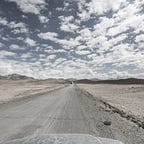The Making of The Handbook
The journey from author to writer.
(If you enjoy the process of book design, hear me and Craig Mod discussing the Handbook in On Margins podcast.)
Last week I launched a Kickstarter for The Field Study Handbook. It’s a professional’s guide to travelling anywhere, making sense of the world and using that knowledge to make a difference. There are unusual rewards.
It took six years it took to bring this project to life from initial concept to delivery. The last three years have been intense — rising most days at 4 or 5am for a few hours of absolute focus until the first stirrings in the house.
A lot has changed in these six years: my home base moved from Shanghai to San Francisco, my daughter has grown from an infant to a young girl, I started my own studio and co-founded another, published two other print books — Hidden In Plain Sight (co-written with Simon Steinhardt), and Today’s Office — as well as numerous Studio D client publications. I’ve racked up three passports worth of travel and also started a luggage brand that morphed from another side project into small business.
I’ve come to realise that the most rewarding travel includes familiar rituals in unfamiliar environments. Writing has been omnipresent , regardless of time-zone or altitude. I’ve enjoyed seductive vistas over these six years, from the dust devils on the Bolivian salt flats to rainfall over the Irrawaddy Delta, as well as my home-base studios in Shanghai, San Francisco, and Tokyo. There were plenty of the less seductive vistas too, the challenge of balancing work-travel-family.
I only had one rule in writing the Handbook: to ensure there was sufficient time and space to appreciate every step of the journey, regardless of how long it took. I don’t assume to have another opportunity.
Like all good creative endeavours, the journey shaped what the book became. The initial goal was modest: a how-to book that shared process of fieldwork. It morphed into a how-to, why-to book, that frames the team’s intent with the world out there and spans the process from pitch to becoming the perceived wisdom. I spun out a second, booklet called Sustainable Data—probably the only book that can be filed under Data, Ethics, Gardening or Cooking, and now published as a soft back. The Studio is also publishing a template kit for practitioners, and our sister luggage brand SDR Traveller launched a tie-in travel folio.
Unlike my first two books I decided to self-publish, motivated by taking on a large book design project, and learning about publishing and fulfilment. Lee John Phillips came on board to provide beautiful technical illustrations, initially for 6 weeks, then for half a year+. All told, that added a glorious year.
Along the way, I’ve enjoyed long conversations and the wisdom of Craig Mod, Ben Barry, Kevin Kelly, Hugh Howey and Charles Spreckley, each of whom is figuring out ways to further the publishing craft. Craig and Dan Rubin’s recently published Koya Bound provided a timely reminder of the power of Kickstarter, and they repeatedly nudged (they would say dragged) me in that direction. I committed to a Kickstarter only two weeks prior to launch — and getting everything in place involved lots of string and duct tape. In turn, I hope this book, website, the community of practitioners, digital assets, tie-in products, workshops, expeditions and consultancy services help nudge people to reconsider what a “book project” can be.
At the outset I realised that many of the breaks in my career came through conversations that were triggered by things I’d published, starting out with my blog future perfect, where over time I found my voice, and over time graduating to more established media.
For my first book, I received an advance from Harper Business, and it took two years from outline to delivering the manuscript. I’m grateful for the experience but was also frustrated at the distance between myself and the final artefact, and to readers.
How is it possible to be an author, and not a writer?
My distinction is as follows:
An author is published, has their name on the cover or byline. There are many ways to get there, particularly when you work for a corporation with contacts in the right places, and not all of it is on personal merit.
A writer, on the other hand can consistently produce words worth reading.
So much of client work is about realising someone else’s vision of the future.
For once, I can say, “This is me” — enjoy.
You can now buy the Handbook.
Jan is the Founder and Director of Studio D. Sign-up to the Dispatch Mailing List.
